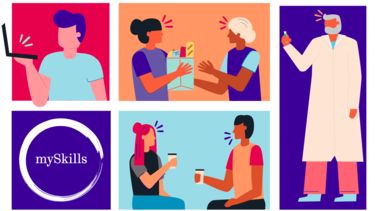Generative AI and academic integrity
Guidance on how to use Generative AI ethically and appropriately.
What is Generative AI?
Generative AI (GenAI) is a specific form of Artificial Intelligence that draws on large datasets to create content such as text, images, video or code. GenAI can replicate different styles to produce outputs that can mimic or emulate authentic individually produced work.
Our understanding of how GenAI can be used effectively as a tool for learning is still evolving, but we are committed to ensuring that you are supported to develop AI literacy without compromising the principles of academic rigour and integrity.
Google Gemini is the supported GenAI tool at The University of Sheffield. However you may also have interacted with GenAI through the use of specific AI tools such as ChatGPT or DeepSeek, or indirectly through GenAI-enabled applications such as Grammarly or Microsoft Office.
For more information on how to use GenAI to support your learning, visit the StudySkills@Sheffield Generative AI hub:
Visit the StudySkills@Sheffield Generative AI Hub
What are the risks of using Generative AI?
There are a number of risks to be aware of when using GenAI. GenAI responses are not held to the same expectations of accuracy, integrity and ethics as students and staff in academia. Inappropriate use of GenAI tools could represent academic misconduct in the following ways:
- Plagiarism: submitting work or ideas that are not your own, and not attributing the work of others through appropriate referencing. For example, using a GenAI response as if it is your own work, or using an idea given to you by a response, without being able to know and reference where GenAI found the original idea.
- Buying or commissioning work: submitting work that you have requested a service to produce, and submitting it as if it is your own work. Even if you have used a free GenAI tool, this is still academic misconduct if you claim it is your own work.
- Coursework sites: the University does not support the use of sites that share content such as lecture notes, essays, lab reports or exam questions. GenAI may be taking its responses directly from these prohibited sites without you knowing.
- Fabrication: submitting work where some information is made up, such as quotations, results of experiments, or survey findings that are not true. GenAI does not have the capacity to judge whether its sources are objectively true or accurate and can give a convincing response to a question that it has found no answer for - this is sometimes called AI ‘hallucination’.
- Collusion: submitting work that has been created with the help or input of other people as if it is your own work in an assessment that does not permit group work. If more than one student has been using GenAI responses within their work and these are similar, this could look like collusion.
Note: You won't be penalised for declaring use of AI where this is in line with assessment guidance. However, even if you make a full disclosure of your use of GenAI, if this is not specifically permitted in your assessment criteria and guidance, or extends beyond what is permitted, there is a risk of this use being considered an unfair advantage, and therefore academic misconduct. It is therefore important to check your assessment guidance before you use any AI tools within your assessments.
For more information about academic misconduct, visit the StudySkills@Sheffield Academic Integrity page:
Visit StudySkills@Sheffield Academic integrity
GenAI detection tools
GenAI detection tools are not used at the University of Sheffield. This is due to concerns over their error rates and the potential for both false positives and false negatives when scanning for potential use of GenAI.
Instead, the University is aiming to support students and staff to take a positive approach to the ethical and responsible use of GenAI, in line with our Principles for Generative AI in learning and teaching.
Visit the Generative AI Principles for Students
Using GenAI ethically and appropriately
In spite of the risks outlined above, when used ethically and appropriately GenAI has the potential to be a powerful tool to support your learning. Follow these key points to make sure that you are upholding academic integrity in your use of GenAI:
- The golden rule: always check your school / department’s guidance and the specific module assessment criteria as the use of GenAI may be specifically prohibited on certain modules or assessments. If you have any doubt at all about this, always ask the module tutor for clarification.
- GenAI outputs should not be used as sources for assessment and you should never cite anything from a GenAI tool. This is because content generated by GenAI tools is not reliable and is usually non-recoverable and non-reproducible at a later date, so it cannot be retrieved from a link or citation.
- Do not copy and paste content from an output produced by a GenAI tool directly into your work. Instead, you should use an output as a way to inform your further research and thinking.
- A full disclosure of any content produced by GenAI should always be acknowledged in your work. Attempts to pass off content as your own work is counted as academic misconduct and may lead to action being taken against you.
- Just because you can use GenAI for an assignment, doesn’t mean that you should. In most cases your own ideas, knowledge and experience will provide the most valuable starting point. Using GenAI can be a way to shut down and narrow your own creativity, as well as a way to enrich it.
- You should not provide any personal, private or confidential information in your prompts.
Use the Generative AI Assessment checklist to make sure you have used GenAI appropriately in your work:
Access the GenAI Assessment checklist (Google doc)
Next Steps

mySkills
Use your mySkills portfolio to discover your skillset, reflect on your development, and record your progress.
